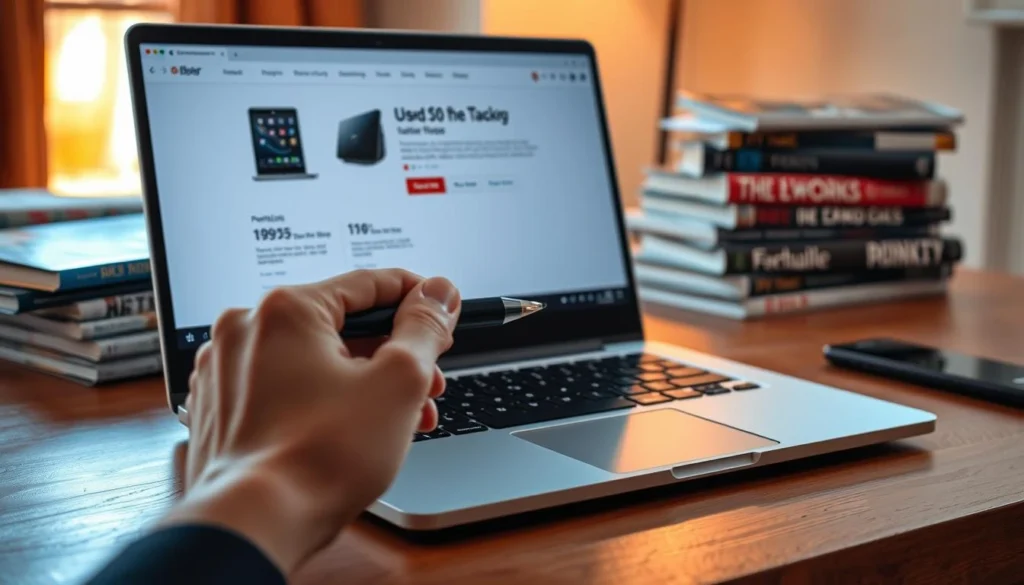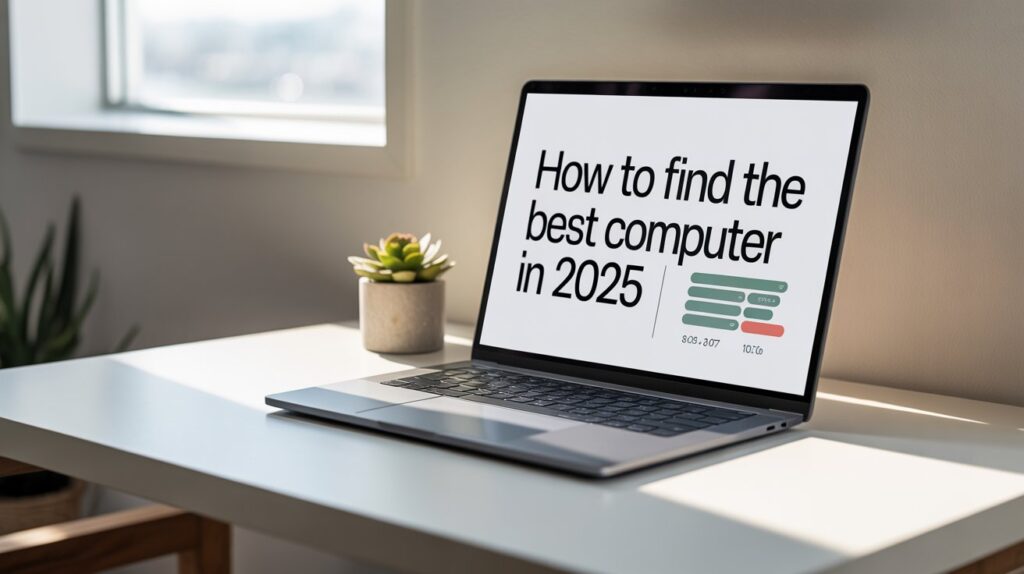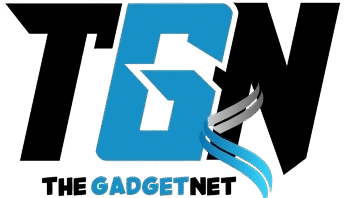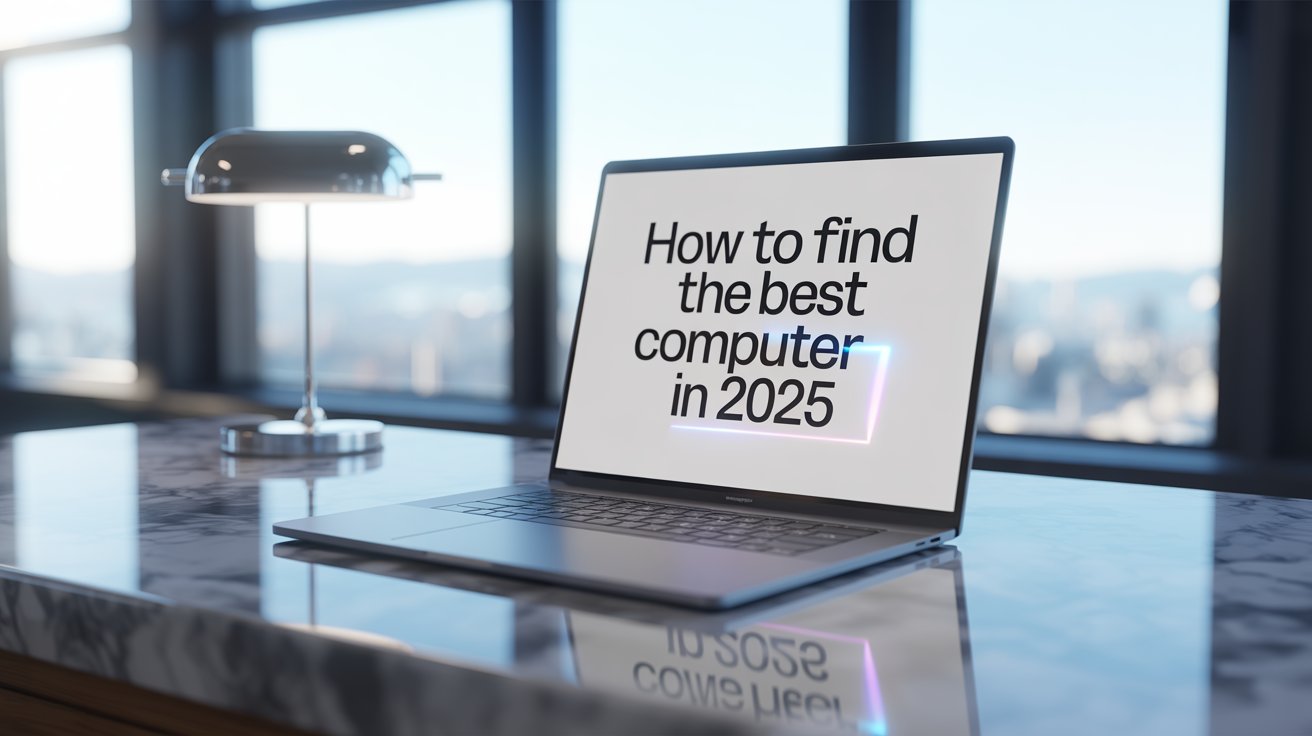Selecting the right computer in 2025 requires balancing performance, portability, battery life, price, and future-proofing. Whether you’re a student attending classes and handling coursework or a professional running demanding software, the right machine can dramatically improve productivity and comfort. This guide explains how to find the best computer in 2025 step-by-step, covers the most relevant specifications and features to evaluate, and includes practical buying tips and recommended configurations for different user types.
Table of Contents
- Introduction
- Why choosing the right computer matters in 2025
- How to find the best computer: a step-by-step framework
- Define your needs and use cases
- Set a realistic budget
- Choose between laptop, desktop, mini PC, or tablet/convertible
- Understand key hardware components
- Evaluate display, keyboard, ports, and build quality
- Consider operating system and ecosystem
- Battery life, thermals, and noise
- Connectivity and future-proofing
- Warranty, support, and software considerations
- Recommended specs and configurations by user type
- Students (general, STEM, design/media)
- Professionals (office, software developers, creatives, data scientists)
- Top buying scenarios and sample builds for 2025
- Where to buy and how to compare deals
- Frequently asked questions (FAQ)
- Conclusion: final checklist and actionable steps
Introduction
The phrase how to find the best computer is central to this article. With rapid advances in processors, integrated graphics, AI accelerators, and battery efficiency, 2025 offers a wider range of compelling choices than ever. This guide is designed to help students and professionals cut through marketing noise and choose a device that delivers the best value and productivity for their needs.
Why choosing the right computer matters in 2025
- Performance diversity: Low-power chips are capable of everyday tasks, while high-core-count CPUs and discrete GPUs handle demanding workloads. Picking the wrong class wastes money or productivity.
- AI and on-device acceleration: More devices include AI engines. Applications from note-taking to coding assistants use these, affecting CPU/GPU/accelerator choices.
- Longevity and sustainability: Devices are increasingly repairable and modular; choosing the right machine can extend usable life and reduce long-term cost.
- Ecosystem lock-in: Operating systems and cloud services influence workflow—pick one that aligns with your tools and collaboration needs.

How to find the best computer: a step-by-step framework
1. Define your needs and use cases
Begin by listing what you’ll do most often. Example categories:
- Web browsing, note-taking, streaming (light)
- Office productivity, spreadsheet-heavy work, virtual meetings (moderate)
- Programming, virtual machines, local servers (heavy)
- Photo/video editing, 3D, CAD, gaming (very heavy)
- Machine learning model training/inference (specialized)
Map tasks to required resources (CPU, RAM, GPU, storage, battery life). This first step drastically narrows choices.
2. Set a realistic budget
- Entry-level: 300–\600 — basic laptops, Chromebooks, or mini PCs suitable for light tasks.
- Mid-range: $600–$1,200 — balanced machines for students, professionals, and light creative work.
- Premium: $1,200–$2,500+ — high-performance laptops/desktops for professionals, creators, and heavy multitaskers.
Consider total cost of ownership: warranties, accessories (dock, external monitor), software licenses, and upgrades (e.g., extra storage, RAM).
3. Choose between laptop, desktop, mini PC, or tablet/convertible
- Laptop: Best for portability. Ideal for students and many professionals.
- Desktop: Best performance per dollar and upgradeability. Ideal if mobility is not required.
- Mini PC/NUC: Space-saving desktop alternative with good performance for office tasks.
- Tablet/Convertible: Great for note-taking and light creative work; consider if touchscreen and pen support matter.
Ask: Is portability essential? Will you use an external monitor regularly? How important is upgradeability?
4. Understand key hardware components
- CPU (Processor):
- For 2025, mainstream choices include high-efficiency mobile chips (e.g., Intel Meteor Lake successors, AMD Ryzen 8000/9000 mobile families, Apple M-series successors) and desktop CPUs with more cores for heavy tasks.
- For everyday tasks: 4–6 cores are sufficient.
- For developers/creatives: 6–12 cores or more.
- For compute-heavy workloads: prioritize higher core counts and single-thread performance.
- GPU (Graphics):
- Integrated GPUs are enough for most students and office work.
- Discrete GPUs (NVIDIA, AMD, Apple GPU on M-series) are necessary for video editing, 3D, gaming, and ML acceleration.
- Consider VRAM size: 6–8 GB for moderate creative tasks; 10–24+ GB for serious content creation and ML.
- RAM (Memory):
- 8 GB: bare minimum for light use.
- 16 GB: recommended for most students and professionals.
- 32 GB+: recommended for heavy multitasking, virtual machines, large datasets, or professional creative work.
- Storage (SSD):
- NVMe SSDs (PCIe 4.0/5.0) provide fast boot and load times.
- 256 GB minimal; 512 GB recommended for students; 1 TB+ for creators and pros handling large files.
- Consider external or cloud storage for backups and archival.
- AI accelerators / NPU:
- Built-in neural processing units speed up on-device AI features (auto-summarization, transcription, coding assistants). Useful but not always essential—prioritize if you rely on AI workflows.
5. Evaluate display, keyboard, ports, and build quality
- Display:
- Size: 13–14″ for ultraportables, 15–16″ for balanced productivity, 17″+ for desktop replacements.
- Resolution: 1080p is standard; 1440p (QHD) or 4K for creative work or high-density displays.
- Panel type: IPS/mini-LED/OLED for color accuracy and contrast.
- Color gamut: sRGB for general use, Adobe RGB / DCI-P3 for creators.
- Brightness: 300+ nits recommended; 500+ nits outdoors.
- Refresh rate: 60Hz sufficient for most; 120Hz+ for smoother UI and gaming.
- Keyboard & Trackpad:
- Comfortable travel and layout are important for students and professionals who type frequently.
- Backlit keys are useful for low-light study/work.
- Ports:
- USB-A and USB-C/Thunderbolt for peripherals.
- HDMI/DisplayPort for external monitors.
- SD card slot for photographers.
- Ethernet (or USB-C to Ethernet adapter) if you need stable wired networking.
- Build & Thermals:
- Metal chassis improves durability and cooling.
- Thermals affect sustained performance—look for reviews on throttling.
6. Consider operating system and ecosystem
- Windows: Broad software compatibility—best for most professionals and students who need legacy or specialized software.
- macOS: Excellent for creative workflows, battery life, and continuity across Apple devices. Apple Silicon (M-series successors) offers strong performance and efficiency.
- Chrome OS: Lightweight, secure, and budget-friendly for students primarily using web apps.
- Linux: Preferred by developers and researchers; consider compatibility and hardware driver support.
Think about ecosystem services (cloud storage, device integration, software subscriptions) and which OS aligns with your primary tools.
7. Battery life, thermals, and noise
- Real-world battery life varies. For students and professionals needing all-day use, aim for 8+ hours in real-world tasks.
- Manufacturers often quote ideal numbers; check independent reviews for realistic estimates.
- Thermals impact performance—quiet cooling and efficient thermal design avoid noisy fans and performance throttling.
8. Connectivity and future-proofing
- Wi-Fi 6E or Wi-Fi 7 in 2025 improves wireless throughput and latency—valuable in congested networks.
- Bluetooth 5.3/5.4 for accessories.
- Thunderbolt 4 / USB4 for fast data, external GPUs, and docking.
- Consider RAM and storage upgradeability—some laptops lock components; desktops usually allow easier upgrades.
9. Warranty, support, and software considerations
- Standard warranty is often 1 year; consider extended or accidental damage protection if you travel or use the device heavily.
- Student discounts and corporate programs can reduce cost.
- Preinstalled software and bloatware can impact performance—clean installs are an option for advanced users.
Recommended specs and configurations by user type
Students — General (notes, web, streaming, office)
- CPU: Modern 2–6 core (Intel U-series, AMD Ryzen 5000/7000 U-series, Apple M-series entry)
- RAM: 8–16 GB
- Storage: 256–512 GB NVMe SSD
- Display: 13–14″ 1080p, matte or low-glare
- Battery: 8+ hours real-world
- OS: Windows or Chrome OS (depending on course requirements)
- Example: 14″ laptop, 16 GB RAM if budget allows — balances multi-tab browsing and light multitasking.
Students — STEM / Engineering
- CPU: 6–8 cores or more (good multi-threaded performance)
- RAM: 16–32 GB
- Storage: 512 GB–1 TB NVMe
- GPU: Discrete GPU recommended for visualizations; NVIDIA RTX 40/50 series mobile or equivalent
- Display: 15–16″ 1080p or 1440p
- Example: Mid-range to high-end laptop or compact desktop for simulation workloads.
Creatives — Photo & Video Editors, Designers
- CPU: 8+ cores
- GPU: Dedicated GPU with 8–16+ GB VRAM
- RAM: 32 GB recommended (16 GB minimal)
- Storage: 1 TB NVMe + external RAID or network storage
- Display: 16″ 1440p or 4K OLED/mini-LED with wide color gamut (P3/Adobe RGB)
- Example: High-end laptop with Apple M-series Pro/Max/Ultra alternatives or Windows workstation.
Professionals — Office, Business, Remote Work
- CPU: 4–8 efficient cores (for battery life and multitasking)
- RAM: 16 GB
- Storage: 512 GB
- Battery: All-day performance with fast charging
- Connectivity: Thunderbolt, Wi-Fi 6E/7
- Security: TPM, optional biometrics for business use
- Example: Ultrabook with enterprise support and docking options.
Developers & Data Scientists
- CPU: 8–16+ cores for local builds and container workloads
- RAM: 32–64 GB for large datasets and multiple VMs/containers
- GPU: Discrete GPU for ML workloads (CUDA support preferred)
- Storage: 1 TB NVMe + external storage
- Example: Desktop workstation preferred for heavy ML training; high-end laptop for mobile dev with docking solution.
Top buying scenarios and sample builds for 2025

- Budget student laptop: 14″ 1080p, 8 GB RAM, 256 GB NVMe, Intel/AMD entry CPU or Chromebook — 350–\600
- Balanced student/professional: 14–15″ 1080p, 16 GB RAM, 512 GB NVMe, efficient CPU with integrated GPU — $700–$1,200
- Creator workstation laptop: 16″ 1440p OLED, 32 GB RAM, 1 TB NVMe, M-series Pro/Windows with RTX-class GPU — $1,800–$3,000
- Desktop workstation: Mid-tower with Ryzen/Intel 12–16 core, 32–64 GB RAM, RTX 40/50 series or equivalent, 1–2 TB NVMe + HDD for archive — $1,500–$4,000 depending on components
Where to buy and how to compare deals

- Buy from reputable retailers or manufacturer stores (Amazon, Best Buy, direct manufacturers).
- Use price trackers and back-to-school/student discounts.
- Compare return policies and warranty terms.
- Check independent review sites and benchmarks for thermal performance, battery life, and real-world workloads.
- Consider refurbished or certified open-box units for savings—ensure warranty coverage.
Frequently asked questions (FAQ)
Q: How much should I spend on a computer in 2025?
A: For students, $600–$1,000 will typically cover a versatile machine. Professionals needing high performance should budget $1,200+ depending on workload.
Q: Is a Mac or Windows PC better for students?
A: It depends on coursework and software requirements. Mac is great for creatives and general reliability; Windows is more versatile for specialized academic software and gaming. Chrome OS is best for budget-focused students who primarily use web apps.
Q: Do I need a discrete GPU?
A: Not for general productivity or web tasks. Yes for video editing, 3D, CAD, gaming, and many ML workflows.
Q: How important is 4K resolution?
A: 4K improves detail but uses more battery and reduces battery life. QHD (1440p) is often the best compromise for high DPI and battery life.
Q: Should I buy a laptop with upgradeable RAM and storage?
A: Upgradeable components extend device lifespan and are recommended, especially for professional use.
Conclusion: Final checklist and actionable steps
- Define needs: List your core tasks and peak workloads.
- Set budget: Decide on total budget including accessories and warranties.
- Pick form factor: Laptop vs desktop vs convertible vs tablet.
- Choose specs: Prioritize CPU, RAM (16 GB recommended for most), and SSD size (512 GB recommended).
- Check ports & display: Ensure ports for your accessories and a display that matches your workflow.
- Verify battery & thermals: Read independent reviews for real-world battery life and thermal behavior.
- Future-proof: Look for Thunderbolt/USB4, Wi-Fi 6E/7, and upgradeability if possible.
- Buy from reliable sources: Use discounts, read return policies, and consider extended warranties.
By following this structured approach, you’ll be well-equipped to answer how to find the best computer for your unique needs in 2025. Start by defining your use cases, then match them to the recommended specs above; this will ensure you get the best combination of performance, portability, and value.
If you’d like, tell me:
- Your primary use cases (study subjects or professional tasks),
- Your preferred form factor (laptop/desktop/tablet),
- And your budget range.


